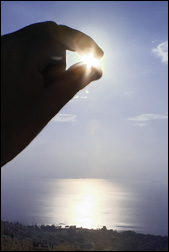
Chapter 2

A Journey through Digitaly - reach for the rays.
The gift for the enthusiastic
infrared-newcomer, courtesy by the camera-industry with their up to 1200nm sensitive
imagers is in hands reach. Which means NOT at hand ;-)
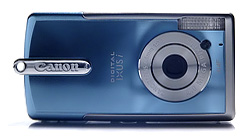
There it is, the shiny new
digital camera, waiting to be whipped through all the wavelengths - but how
do you know if your camera is capable of doing so?
The answer is: Screw, glue, clip or for the sake of it weld a filter to it and
see for yourself how efficient the built in IR-cut filter is doing it's work!
There are some voodoo-tricks hovering around about how to really test your camera
before buying any filters - the most common and easiest to do for almost everybody
is the "remote-test". Hold any infrared emitting remote from your
tv set or HiFi-rack in front of the camera, best use a button that repeatedly
fires signals (volume would be a good choice) and check if at all or how much
you can see from the infrared light. After all, this is fun, wee, and a good
hint on what is to be expected to be found later on.
Only - an exact prediction of the sensitivity is not really possible this way
- is it strong, quite visible or weak? How'd you compare? How far into the near
infrared does your light reach? Only a very binary statement can be given -
Yup or nope.
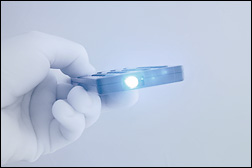
"Nope" would be a little suspicious anyway, every camera can look
at least a little way into IR.
Depending on your type of adventuresomeness you will be able to bring up more
or less enthusiasm for the tasks at hand - NIR-photography is by no means fast-food,
nothing that is done by "automatic" and "default" mechanisms.
You want jaw-dropping results? Yep, gotta work quite a bit for that, but you
can do it ;-)
One of the very few constants in this area is this - the older the camera (up
to MFD 2002) the bigger your chances to snatch one with high sensitivity or
at least one that is quite easily modified.
eBay is a good start, the nice thing about digital cameras is that as trend
ware they are bound to be "out" after a very short while only, because
it is mandatory to have the latest "megapixelmorethanyourneighborhas"-model,
innit? ;-)
Cameras that have proven to be able to produce wonderful images in the right
hands are (not a complete list):
Nikon Coolpix 990 and 995,
Canon Powershot G1 and G2, Olympus C20x models, Sony Cybershots S70, S75, S85
and partially F707 and F717.
There are numerous cheaper releases from OEM-manufacturers in Taiwan or China,
mainly "old" electronics which sometimes yield astonishing sensitivity
- sometime one can make a catch there, too.
Digital Single Lens Reflex cameras which have earned a reputation are Canon
D30, Nikon D1 and Kodak DCS520-760 - none of which are really to come by very
cheap still.
Sony would offer THE perfect solution for the poor infrared aspiring photographer
- the cameras with the elusive Nightshot capability swivel away the IR-cut filter!
That would be exactly what we'd like - if there wasn't an if. In this mode you
cannot close down your aperture, it is locked wide open (bah!), fastest shutter
time is 1/60sec. and the slowest 6 sec.. It would be an easy task for the programmers
to change the firmware in this regard - they just didn't and no "hacker"
has been dug out so far that could hack the firmware. So all the owners of these
cameras are able to do is to cascade ND-filters to get a decent exposure. I
did not mention that in this mode there is no such thing as color-decoding as
well, so even with a decent exposure the camera would only be able to capture
"real" IR, which is not a really bad thing ;-)
The newer the model the more difficult it gets. Noise response in "system-cameras"
has not really improved in the last years to say the least - thanks you marketing
guys for fighting for shares with this stupid megapixel number! Same sized sensor
dimension, smaller and more,more more of the even smaller and smaller photo-cells
- an open invitation for noise. But thank the higher spirits, there is SOFTWARE,
this magical instrument that can even repair shattered images even before the
customers gets to see his results. So while the sensors are declining in output
quality they add cool new cpus to do the repairing - wonderful that everything
ADDED is to be sold as bonus and added value ... but that's how it is.
If the camera is tightly cut to the visible spectrum a tough ride stands ahead
and expected picture quality is not too high.
Focusing capability is very
important, too, if the camera cannot auto focus through the filter or the manual
focusing is too crippled to get a certain value - you won't get focused images.
Sony`s amplify the image on focusing, that's a nice trick, Fujis for example
don't do nothing like that. They can't auto focus and you are really alone when
trying to manually focus an image - no infinity setting, focusing ring (S602z)
without mechanical stop - this way creative play is very tedious.
The DSLR -department is not looking too bad anymore. Even with a Canon 10D a
knowing photographer is able to produce stunning pictures, even easier with
a Nikon D70, the Sigmas with their Foveon-CCDs do like to shed quite some noise
but at least the SD10 is very easily modified for high speed IR. Pentax, Minolta
and Olympus have not found their way into my trusting hands, Fuji's S2pro would
make a decent choice if there weren't those ugly noise artifacts Fuji claims
to be "normal", S3pro needs to find her way to me, too, but i am not
too enthusiastic about this model, too.
The most important ingredient with DSLRs is very so true with system-cams, too
- the lens.
Depending on the kind of coating of the glasses and the material used on the
inside of the tube many lenses are plain not useable in IR-photography. There
is this kind of ghosting caused by, dunno, i guess reflections between the elements
or/and the walls which manifests as a more or less round spot in the middle
of the picture, a.k.a. CenterSpot. Good thing about changeable lenses is the
changeable bit - just try another one. When a system camera shows a strong spot
- it makes it the end of the journey for it this early.
Every lens has a certain degree of light falloff to the corners, this can also
be interpreted as a spot - but a strong CenterSpot visibly "fogs"
the image in its radius, depending on angle to the light source and aperture.
The DIY-shed.
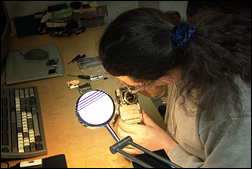
If a manufacturer inserts
some kind of mechanical thingy that hinders something i would like to have -
can i not remove that thingy?
Yes! No... depends...
Personally i would always go the extra mile to achieve what i have decided to
happen in my head - but i understand that not everybody has this, sometimes
quite destructive attitude. So a word of warning needs to be said - you CAN
modify your camera and if all goes well be a very happy camper indeed - BUT,
working about the delicate electronics and miniature boards, most of all the
highly loaded flash capacitors can be LIFE THREATENING.
Just so you know ;-) Please read more on that issue in the "IR Cut-filter
removal"-chapter.
Fun factor - hihi.
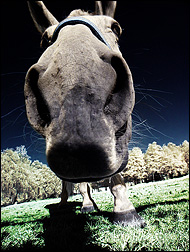
The general statement is:
Cameras with installed cut-filter need long exposures to literally force the
waves through - along with all the disadvantages long exposures bring along.
The most threatening fact is that noise levels rise with longer exposures. Another
thing is a sword with two edges - if you need to expose long a tripod is mandatory.
As of course i am aware, really serious photography can only be done from a
tripod anyway, but the first days/weeks of playing and finding the way around
the infrared viewing capability quick response, best real time preview of a
scene needs to be at hand for a deep experience.
My highly subjective opinion here is that everybody interested in the possibilities
offered by the invisible world needs to do all he/she can to get his/her fingers
on a fast IR-cam. The things to be discovered are a high reward for all trouble.
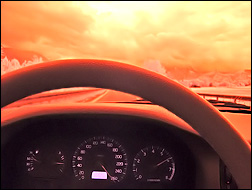
Summary:
Fast or slow? This question
is the big one after the first tests with the projected camera. Analog or digital?
No matter what the decisions are - at some point in time you cast off - here
we do that in the next chapter ;-)